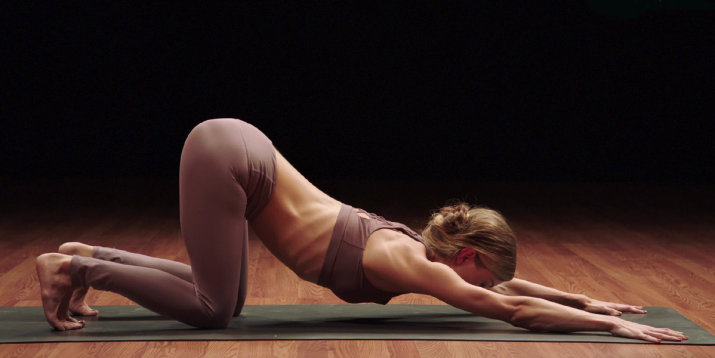How to Get a Feel-Good Stretch from Puppy Pose

Puppy pose, often referred to as “melting heart pose,” is a cross between downward-facing dog and child’s pose. It is the perfect yoga backbend for beginners, as it is gentle on the shoulders and spine. Puppy pose encourages chest opening, which is a surefire way to offset all the time we spend hunched over screens.
Read on to learn the steps to get into the posture and the benefits of puppy pose so that you can feel as energetic as, well, a puppy.
Puppy Pose: Step-by-Step Instructions
Puppy pose, or anahatasana in Sanskrit, is also called “stretched-out puppy pose.” According to yoga trainer Jennifer Fuller, CPT, RYT-500, puppy pose is an all-over, feel-good pose since it opens the shoulders, back, chest, and arms.
Here are Fuller’s steps to feel your best in puppy pose:
1. Set up the pose
- Start in a tabletop pose (stack your hips over your knees and shoulders over your wrists).
- Engage your belly, by pulling your belly button to your spine.
- Tuck your toes.
- Spread your fingers wide, and gaze in front of you.
2. Getting into it fully
- Walk your hands forward.
- Let your arms fully extend in front of you as your forehead rests on the floor. (If your forehead does not reach the floor, keep your head and neck neutral with your gaze down.)
- Press your palms firmly into the floor to further engage your shoulders. Turn your fingers slightly out toward the edges of your mat.
- Hollow out your armpits, and draw your shoulder blades in, back, and down.
- Soften your heart toward the floor.
3. Focus on alignment
- Keep your hips stacked vertically over your knees.
- Reach your tailbone toward the floor.
- Reach your arms out in front of you. Draw your elbows in line with your shoulders.
Fuller recommends holding puppy pose for 30 seconds to one minute, depending on how you feel.
What Does Puppy Pose Do?
If you work a desk job, puppy pose is the posture for you. Fuller tells us that the primary purpose of puppy pose is to reverse the curve in the upper thoracic spine, which increases spinal flexibility.
Studies show that yoga backbends (even gentler ones like puppy pose) counter sedentary lifestyles by strengthening core muscles to help us stand straighter.
When we practice backbends, we help downgrade the effects of “fight or flight” mode and reduce anxiety and stress, mentions Fuller.
Puppy pose is also a mild inversion that places the heart above the head, which benefits the body by improving blood flow and core strength.
Heart openers like this one open the chest cavity, which may make practitioners feel vulnerable at first. But opening the heart cavity allows us to feel more space in the muscles of our ribcage.
Open-heart poses, confirmed by this 2018 study, increase our energy levels and give us confidence.
Puppy Pose Contraindications and Modifications
Puppy pose is a posture that can benefit just about anyone, but that doesn’t mean it’s easy. Fuller mentions you should pass on puppy pose if you have any knee, shoulder, or hip injuries.
To modify, she suggests:
- Placing your head on a rolled-up blanket, towel, or yoga block.
- Placing both hands on a block.
- Place your hands on a chair, while in a kneeling position, allow your head to hang free.
Next time you hit your mat, try out puppy pose. Give yourself space to release tension from your body, one playful posture at a time.
